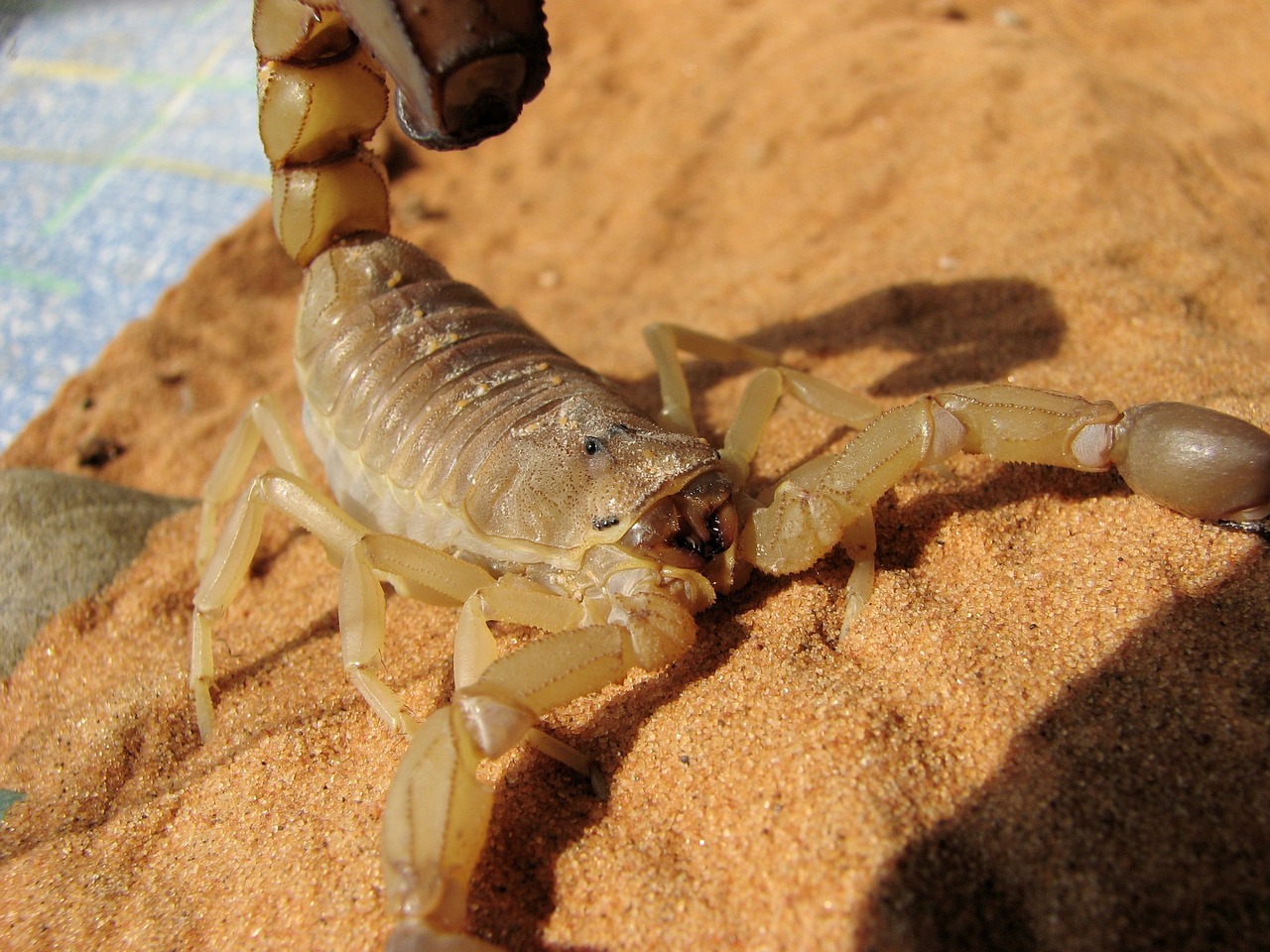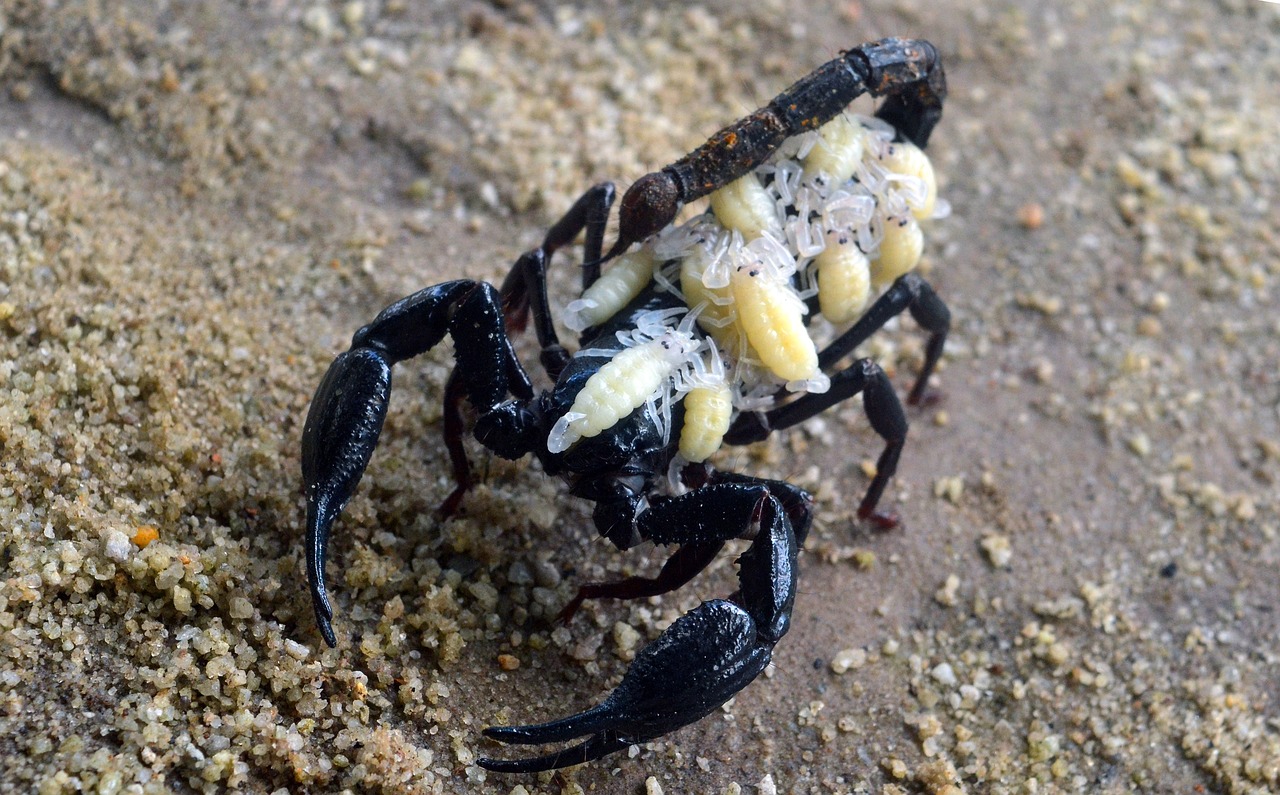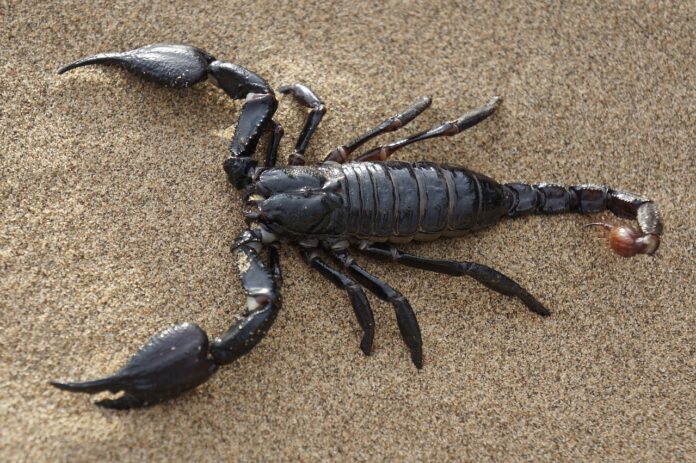Scorpions belong to the order of arthropods and the class of arachnids. They lead a terrestrial lifestyle and prefer warm or even hot climates.
Appearance
Scorpions have a menacing appearance. A large cephalothorax transitions into an abdomen divided into segments. Scorpions possess pincers to grasp their prey. Another pair of front limbs is reduced and located near the mouth, having evolved into chelicerae.
The scorpion’s brain is located directly above the esophagus and is small in size. It is formed by four fused nerve ganglia. A gut runs along the length of the body, connected to a large liver. Gas exchange occurs in the pulmonary sacs, which are paired and located in the third, fourth, fifth, and sixth segments of the body.
The last segment of the abdomen has a pear-shaped structure that houses glands producing venom. The venom is injected into prey through a sharp stinger at the tip of the tail.
Scorpions are protected not only by their venomous sting but also by a tough chitinous exoskeleton, which is nearly impossible to bite through.
Scorpions have well-developed vision. Depending on the species, they have 2 to 8 eyes, located on the top or sides of the cephalothorax.
The body color of a scorpion depends on its habitat and can be sandy, black, green, or even orange. There are even species with completely transparent bodies, which helps them camouflage more effectively.
Scorpions are nocturnal creatures, hiding under rocks and in crevices during the day. They feed on insects and spiders. Scorpions catch their food with their pincers, lift it above their head, and kill it by injecting venom with their sting.
Paleontological Data
Scorpions are one of the oldest orders of arachnids. The first representatives are found in Silurian deposits. Over 130 species of fossil scorpions have been described.
The origin of the order is still debated. Many paleontologists believe that scorpions evolved from eurypterids, which were aquatic creatures. However, there is another viewpoint suggesting that eurypterids and modern scorpions are not related. It remains unclear whether scorpions originally lived in water or if their evolution was entirely terrestrial.
Reproduction
Scorpions are dioecious animals, with males and females differing only in body size.
Males have a pair of testes consisting of longitudinal tubes located near the liver. Each tube has a duct that opens on the ventral side of the abdomen.
Female reproductive organs also consist of tubes, connected by numerous ducts. These tubes form ovaries, from which oviducts extend. The oviducts have expansions called receptacles, which combine into a single duct that opens on the ventral side of the body.
Both males and females have reproductive openings covered by a genital operculum, a plate formed by modified limbs.
Scorpions are viviparous, meaning their offspring develop inside the mother’s body. They do not undergo metamorphosis. Females care for their young, protecting them and providing food. However, under unfavorable conditions, a female may consume her offspring.
Scorpion Venom Poisoning
A scorpion sting is often more painful than a snake bite. Some species are so venomous that their sting can be fatal, especially for children and the elderly.
The sting site swells and reddens, and a blister filled with clear fluid may appear. Symptoms of scorpion venom poisoning include:
- Severe headache, dizziness, and loss of consciousness
- Weakness
- Fever or hypothermia
- Convulsions (especially common in children)
- Increased heart rate
- Shortness of breath, feeling of suffocation
- Excessive tearing and nasal discharge
This reaction is caused by the venom of tropical scorpions, which pose a threat to large mammals and humans.
If someone is stung by a scorpion, first aid is essential. The person should be laid flat with their head elevated, and a cold compress applied to the sting site to slow the absorption of venom into the bloodstream. If stung by a dangerous scorpion species, medical attention is required to administer a specific antidote.
Interesting Facts
Scorpions are quite unique animals. Here are a few interesting facts:
- Only the venom of 50 scorpion species is dangerous to humans. There are over 1,700 species in total.
- The imperial scorpion is 20 centimeters long, making it the largest arachnid on the planet.
- In ancient Egypt, scorpions were considered the embodiment of the goddess Selket, the protector of the dead.
- Less venomous species are popular as pets. They require little care, infrequent feeding, and can be kept in small aquariums.
- Scorpions have a long lifespan: 3 to 10 years. In captivity, this can increase.
- Scorpions molt regularly. Their age is determined by the number of molts. Before reaching sexual maturity, scorpions molt 5 to 7 times. After shedding their old exoskeleton, their bodies become soft and almost transparent. During this vulnerable period, they prefer to hide.
Scorpions may terrify many people, but they rarely attack unprovoked. They only sting when stepped on or disturbed. In areas with large scorpion populations, it’s essential to be cautious, especially when moving around at night.
